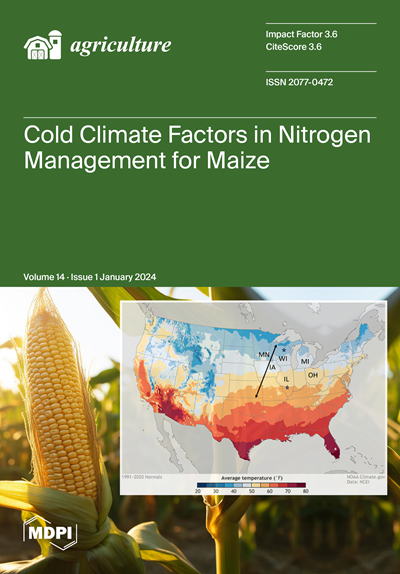Total Mixed Ration Silages Based on Forage Cactus and Xerophile Legumes as Alternatives for Ruminants
IF 3.6
2区 农林科学
Q1 AGRONOMY
引用次数: 0
Abstract
This study aims to evaluate the fermentative profile, fermentative losses, microbial populations, aerobic stability, chemical composition, and in situ degradability of total mixed ration silages based on forage cactus associated with xerophytic legumes. The treatments consisted of four total mixed ration silages based on forage cactus and concentrate (TMRC), associated with legumes such as Gliricidia sepium (TMRG), Leucaena (TMRL), and Senna obtusifolia (TMRS). There was a significant difference (p < 0.05) among the evaluated treatments for the pH and NH3-N (% of total N) variables. The pH values remained within the ideal range, from 4.2 to 4.4, and the NH3-N content ranged from 2.21 to 0.85%. The dry matter recovery for the evaluated treatments averaged 89%. The lactic acid bacteria (LAB) counts ranged from 5.0 to 6.3 log CFU/g among the evaluated silages, with TMRC presenting the lowest count at 5 log CFU/g in comparison with the total mixed ration silages associated with legume plants. All of the total mixed ration silages associated with legumes presented an average mold count of 3.3 log CFU/g. Yeast populations were observed only for TMRG at 5 log CFU/g. A higher aerobic stability was observed for TMRC, followed by TMRG and then TMRS. In conclusion, the total mixed ration silages associated with G. sepium and S. obtusifolia can be recommended based on their fermentation and nutritional value.以草料仙人掌和嗜干豆科植物为原料的全混合饲料青贮替代反刍动物
本研究旨在评价以牧草仙人掌和旱生豆科植物为原料的全混合日粮青贮的发酵特性、发酵损失、微生物数量、有氧稳定性、化学成分和原位降解性。以牧草仙人掌和浓缩物(TMRC)为基础,配以豆科植物细叶仙人掌(TMRG)、合家乐(TMRL)和塞纳(TMRS) 4种全混合日粮青贮处理。pH和NH3-N(占总氮的百分比)各处理间差异有统计学意义(p < 0.05)。pH值在4.2 ~ 4.4范围内,NH3-N含量在2.21 ~ 0.85%范围内。各处理的干物质回收率平均为89%。所评价青贮的乳酸菌(LAB)数量在5.0 ~ 6.3 log CFU/g之间,与豆科植物相关的混合日粮青贮相比,TMRC的乳酸菌数量最低,为5 log CFU/g。所有与豆类相关的混合日粮青贮平均霉菌数为3.3 log CFU/g。当TMRG浓度为5 log CFU/g时,只观察到酵母群体。TMRC的有氧稳定性较高,其次是TMRG,然后是TMRS。综上所述,从发酵和营养价值两方面考虑,可推荐以黄曲霉和黑曲霉为配种的全混合日粮青贮。
本文章由计算机程序翻译,如有差异,请以英文原文为准。
求助全文
约1分钟内获得全文
求助全文
来源期刊

Agriculture-Basel
Agricultural and Biological Sciences-Food Science
CiteScore
4.90
自引率
13.90%
发文量
1793
审稿时长
11 weeks
期刊介绍:
Agriculture (ISSN 2077-0472) is an international and cross-disciplinary scholarly and scientific open access journal on the science of cultivating the soil, growing, harvesting crops, and raising livestock. We will aim to look at production, processing, marketing and use of foods, fibers, plants and animals. The journal Agriculturewill publish reviews, regular research papers, communications and short notes, and there is no restriction on the length of the papers. Our aim is to encourage scientists to publish their experimental and theoretical research in as much detail as possible. Full experimental and/or methodical details must be provided for research articles.
 求助内容:
求助内容: 应助结果提醒方式:
应助结果提醒方式:


